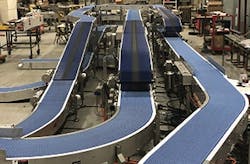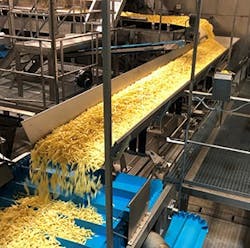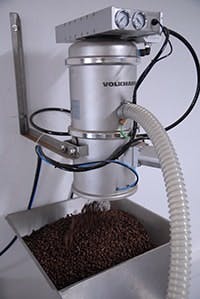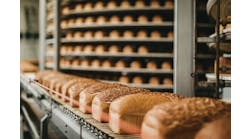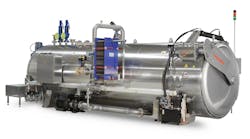Someone once defined a food processing plant as “a collection of conveyors where things occasionally happen.” But before anything can happen, the conveyors have to deliver the goods – literally. That’s sometimes easier said than done.
Material handling often isn’t as straightforward as building a conveyor from point A to point B. Some products are just hard to handle, for various reasons. In other cases, there are a lot of points A and B to take into account, and sometimes they’re not always the same ones, nor in the most convenient places.
Arguably the most universal of challenges when it comes to designing and running a conveyor system is space. A properly configured system will maximize the use of every available square foot. In cases where production has to be increased to meet demand but there is no budget for a new or expanded building, extra conveyor footage is the only practical option.
John Kuhnz, vice president of engineered solutions for Dorner Manufacturing, says he’s seeing more designs like conveyors elevated high above the floor to conserve space. “Hats off to the end users in the food space, because they’ve really become experts in how to maximize that space,” he says.
Tony Maniscalco, business unit leader at SideDrive Conveyor Co., recalled a customer who needed more room for his frozen pizza operation. The freezer’s output point was high off the floor; from there, the conveyor dropped it down a series of transfer points to get it to floor level. This not only took a lot of space, but sometimes damaged the product by jarring the pizza toppings loose. SideDrive installed a spiral conveyor with a diameter of only about 13 ft.
“We actually were able to use the spiral and get a tight fit, descending the product down in one location, which essentially opens up more floor space for the customer,” Maniscalco says. “It eliminates all the transfers and turns in the declining conveyor, thereby saving product loss, because it’s not dropping and bumping and shaking product free.”
The need for speed
Closely related to the space question is the speed question. If demand increases and operations ramp up to meet it, often it can be a simple matter to buy packaging machines fast enough to handle the extra flow. Getting product to those machines, however, is another story. In many cases, the only alternative is to establish extra processing lines; these will often have to be merged into fewer packaging lines.
“So that’s really an example of the challenge that we face, that that packaging equipment has gotten so much faster that these process lines have to be combined,” Kuhnz says.
To feed packaging equipment efficiently, bulk product often must be evenly spread across the conveyor, says Rudy Sanchez, process systems product development manager at Key Technology.
“To solve this issue, we start by customizing our Iso-Flo and Impulse shakers to match the speed of the equipment that each shaker is feeding,” Sanchez says.
“From there, we offer a number of different solutions, depending on each customer’s unique application. For example, we can utilize a diverging or converging lane distribution shaker to evenly spread product across the width of the shaker bed with lanes, or we can utilize a bias shaker when feeding a system at a 90-degree angle.”
Conveyor systems can be set up that will allow for multiple scenarios with individual products. Multi-Conveyor recently built an over/under merge system with product settling for a frozen food manufacturer, which involved handling various sizes of bagged products. Some of the products only require two bag-filling machines, which feed two X-ray lines to case packers. Others need three to meet demand; these feed a transpositor that evenly distributes bags between two upper-level conveyors. This complex yet small-footprint system can also route product into a third bagger if one of the two used for a product ever goes down.
Transferring from higher to lower levels often requires specialized conveyor configurations. Photo: Multi-Conveyor
Options for difficult transfers can be built into a material handling system, says Ricky Milner, line support leader at Wire Belt, a supplier of conveyor belts. A dead plate can be abutted to the discharge point, allowing the product to slide over for easier transfer. In some applications, a live roller can help products cross a gap at a conveyor’s end.
Hard to handle
When it comes to handling non-packaged material – product or the ingredients that go into it – many of the challenges involved in have to do with the nature of that material. Some things are just way harder to handle than others.
Kuhnz of Dorner gives the example of dough-enrobed frozen sandwiches. The fragile and irregularly shaped units have to be handled gently, routed and merged from several lanes into one, while not being allowed to touch.
“Our job is very complex, because you’ve got a product that you don’t want to have roll, you don’t want to have fall apart when you make product transfers,” Kuhnz says. “So not only is the application difficult because of the shape and the fragile nature of the product, but now you’ve got to make all these transitions or product transfers and do it consistently.”
Robots guided by vision systems are increasingly used in material handling to help pick and sort product. With machine learning, they’ve become sophisticated enough to be able to work with irregularly shaped product. But most of them still need to be presented with products that have a margin of space around them, especially if there is more than one robot assigned to a line.
Vibratory or shaker conveyors often have to deal with challenging conditions such as product high in fat or moisture. Photo: Key Technology
“The most challenging task in conveying is aligning products to feed robotic packaging systems,” Sanchez says. “Precise product separation and spreading are critical for enabling the robotic arms to pick up the product efficiently.” To ensure this, Key has developed spreading and alignment shakers with drop steps and lanes, as well as different strokes and speeds, which help ensure proper alignment and minimize the number of touching and overlapping products.
Other aspects can make product hard to handle, especially when it changes its nature under different temperatures. Sanchez gives the example of oily product coming out of a fryer: “If the shaker bed isn’t kept warm, the fat will solidify on its cold surface.” As an option with its Iso-Flo shaking conveyors, Key offers a “steam trace system” that warms the conveyor’s shaker bed to keep the fat liquefied.
Frozen environments are another temperature-related challenge, due to ice forming on top and underneath the belt: “For these low-temperature climates, we design belt conveyors with a specialized tail roll, featuring a shape roller that removes the ice from the belt,” Sanchez says.
The powder problem
Conveyance of granular products – powders and bulk solids – have their own challenges. Usually they’re carried by enclosed, tubular conveyors that either blow product through pneumatically, or carry it along with interior physical motion like a turning auger or disks strung on a cable. The food products often are fragile, like nuts, coffee beans or tea leaves.
There is potential for shearing, with product damage, at the inlet or discharge points. It can be a problem if there is “too much at one time, or the material is just sitting there and getting chomped away as it moves into the flow,” says Karl Seidel, marketing director at Cablevey. This can be taken care of by slowing the flow, perhaps with vibratory feeders.
Coffee beans are among the more challenging materials to convey due to their fragility. Photo: Volkmann USA
Cleaning is a special challenge for enclosed conveyors, especially if product has to be changed often. Cleaning in place, by running cleaning solution and rinse water through the system, is effective but uses copious amounts of water. The alternative is disassembling the system for cleaning; ease of disassembly is a factor to consider in such cases.
“For food and beverage customers managing several changeovers per day, our conveyor receivers are designed to be taken apart quickly, without tools,” says David Nichols, vice president of sales and marketing for Volkmann USA, a supplier of powder and bulk-solids conveyors. “They disassemble in minutes and are easy to move, if desired.”
Flexicon makes various kinds of conveyors for powders and bulk solids, including flexible screw conveyors. The tube is “readily cleaned by removing the end cap and flushing with air, water, steam or cleaning solution, or by removing the screw for sanitizing,” according to a company spokesperson.
Material handling often isn’t a straight line, literally or figuratively. Accommodating a material-handling system to the unique challenges of an application is one of the first steps to a plant with maximum efficiency.

